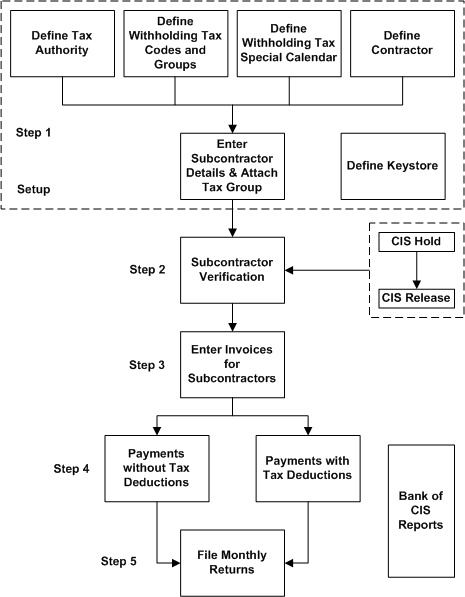Construction Industry Scheme Process
Definition
The UK Inland Revenue’s Construction Industry Scheme (CIS) governs the taxation of certain payments made by contractors to subcontractors from August 1 1999 and the new process to verify subcontractors and report monthly returns introduced from April 2007. The scheme applies to construction work carried out in the UK and also includes jobs such as installation, demolition, repairs, and decorating. The Construction Industry Tax (CIT) scheme preceded CIS and is no longer valid.
Note: CIT information can no longer be entered, but CIT reporting information is included in CIS reports.
Process Flow Diagram
The diagram below shows the Construction Industry Scheme process as described in the accompanying text.

Process Description
The Construction Industry Scheme process is as follows:
-
Setup: Setup tax authority, withholding tax codes, special calendar, define contractors and subcontractors and keystore.
See: Construction Industry Scheme Setup Steps, Oracle Public Sector Financials (International) Implementation Guide.
-
Registration: Contractors and subcontractors must register with Inland Revenue before. Refer to CIS340 Guidelines for additional information.
After registering with the Inland Revenue, contractors and subcontractors are provided with information that populates the Extended Supplier and Reporting Entity windows and to set up the electronic communications with the government gateway.
-
Subcontractor Verification: After the subcontractor registers, Inland Revenue provides the subcontractor with the registration information that must be provided to the hiring contractor who submits a request to Inland Revenue to verify whether the subcontractor is registered Inland Revenue. Contractors can verify subcontractors using the Internet (electronic) or over the telephone (non-electronic). Inland Revenue replies to the contractor with the subcontractor tax treatment, verification status, and verification number.
-
Subcontractor Payments: Contractors use Oracle Payables to enter and pay invoices to subcontractors.
See: Entering Invoices Overview, Oracle Payables User Guide.
See Paying Invoices From the Invoice Workbench, Oracle Payables User Guide.
-
Monthly Returns: Contractors must file monthly returns to Inland Revenue. The monthly returns specifies the gross payments to and deductions from the subcontractors. Use the monthly returns user interface to generate the monthly return submitted to Inland Revenue for the subcontractors.
-
Reports: The following reports can be generated: